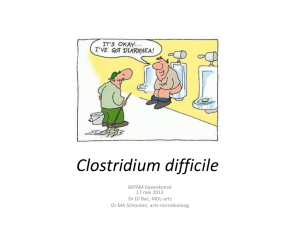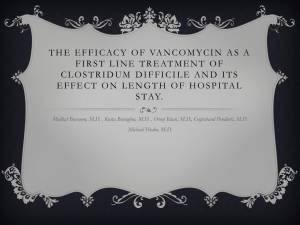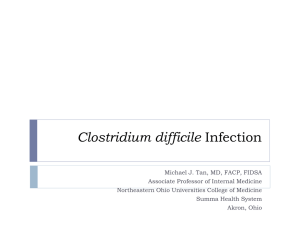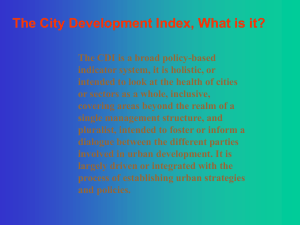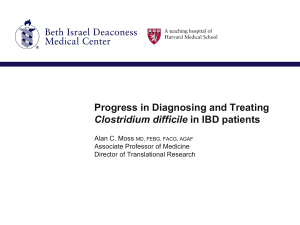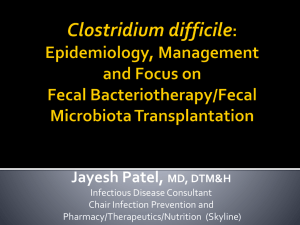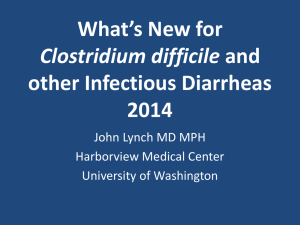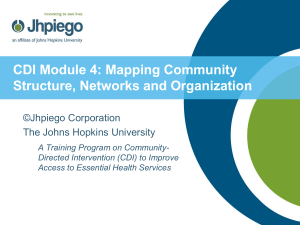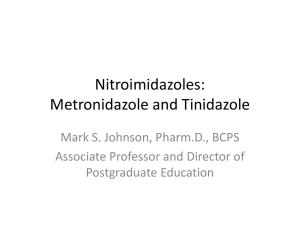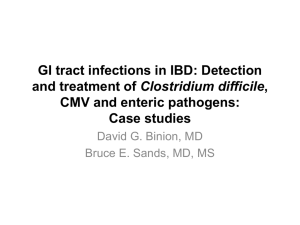C. difficile - Hindson Foundation
advertisement
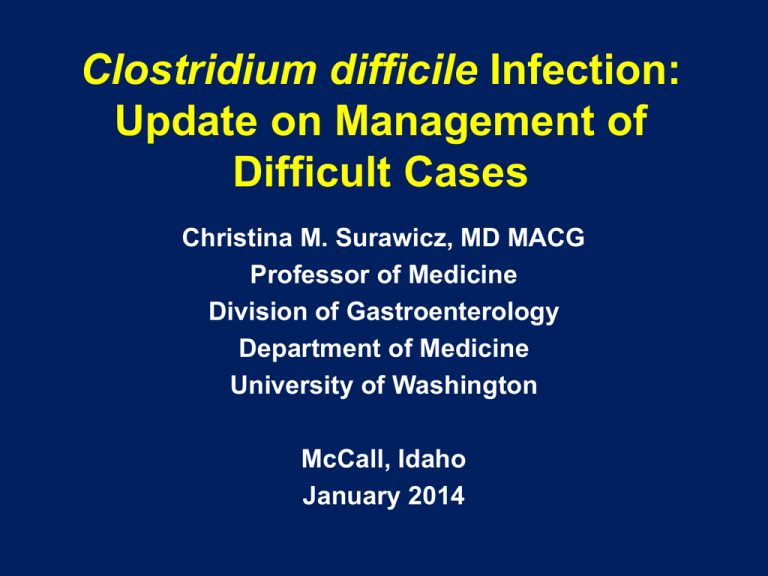
Clostridium difficile Infection: Update on Management of Difficult Cases Christina M. Surawicz, MD MACG Professor of Medicine Division of Gastroenterology Department of Medicine University of Washington McCall, Idaho January 2014 In Vitro Production of Toxins in Epidemic Strain Mutation in gene that regulates toxin production Warny et al Lancet 2005; 366:1079 . First Case of PMC 22 y.o. Woman w/ 3 Months N/V Malnourished (Sir William Osler) Dilated stomach, with palpable mass Surgery – Pyloric ulcer Rx post-op enemas of saline and whiskey Finney, Bull Johns Hopkins Hosp. 1893; 4:53-5 Post-Op Course At 10 days, Diarrhea – Tenesmus + blood Died 15 days post-op Autopsy---“diphtheritic” colitis Pseudomembranes Pre-antibiotic Era – Risk Factors Altered gut flora – GI tract disease – GI surgery – Alcohol enemas Common Risk Factors Antibiotics –in prior 2 months, especially broad spectrum and multiple antibiotics Recent hospitalization or being in a long term care facility Age over 65 Co-morbid conditions Immunosuppression New Risk Factors More community acquired cases Inflammatory bowel disease Pts with IBD and CDI have higher morbidity, mortality, more likely to require emergency surgery PPIs More data favoring PPIs as a risk factor for acquiring CDI Today 1. What are the best diagnostic tests for CDI? 2. How do I choose appropriate therapy for my patients with CDI? 3. When should I get a surgery consult for my patient with CDI? 4. How do I treat patients with recurrent CDI? 1. What are the best diagnostic tests for CDI? Diagnostic Testing Detection of toxin in stools Tests are imperfect and evolving Test only patients with diarrhea since 80% of infants and 5-15% of adults are carriers EIA Tests Toxin A only – will miss 1-3% of Toxin B positive, A negative strains Toxins A + B Specific but not sensitive Should not be stand alone tests GDH Tests GDH is common antigen, glutamate dehydrogenase, Clostridial but not specific for toxin producing C. difficile Very sensitive but not specific Used as screen If negative – no further testing If positive – second step is confirmatory testing like PCR PCR Nucleic acid amplification test – PCR for Toxin B gene Very sensitive and specific PCR real time Expensive but quick and accurate Rapid diagnosis can reduce hospital costs Current Practice in Hospital Labs University Hospitals 2/3 use PCR as stand-alone test 1/3 use GDH with PCR confirmatory (cheaper) Community Hospitals Some still use EIA test Personal communication. Peter Gilligan, UNC, 2012 C. difficile Tests Can now use rectal swabs for PCR Useful if patient has ileus Do not routinely test 3 stools Low yield Don’t test for cure (usually) Culture and toxin can stay positive for a month Khanna et al, J Clin Gastro 2012; 46:846; Wenischet al, Clin Infect Dis1996;22:813; Surawicz et al, Clin Infect Dis 2000; 31:1012-7 A Final Take Home Point PCR is probably the new gold standard BUT diagnostic tests are imperfect If you think your patient has C. difficile and is sick, start empiric therapy 2. How do I choose appropriate therapy for my patients with CDI? 3 Effective Oral Antibiotics for CDI Metronidazole 500 mg tid x 10 days Vancomycin – (FDA approved) 125 mg qid x 10 days Fidaxomicin – (FDA approved) 200 mg bid x 10 days What is Fidaxomicin? Macrocyclic antibiotic – Poorly absorbed Equivalent to vancomycin – mild to moderate CDI Fewer recurrences with fidaxomicin: 15% (F) vs 24% (V) Thus the cost is twice that of vanco Not tested in severe cases or recurrent cases Louie et al, NEJM 2011; 364:422 Cost of Treatment Treatment 10 day cost $15-30 Metronidazole pills (500mg) Vancomycin pills (125 mg) $1,100 IV vancomycin given orally $40-300 Fidaxomicin (200mg) $2,700 CDI Treatment Depends on Severity Mild to Moderate Severe Severe and Complicated Cohen et al, IDSA/SHEA guidelines,Infection Control Hosp Epi, 2010; 31:431 Surawicz et al, ACG guidelines ,Am J Gastroenterol (in press 2013) Mild to Moderate CDI Diarrhea with no criteria for severe CDI Diarrhea ≥ 3 loose-stools/24-hours Treatment of Mild to Moderate CDI Stop intercurrent antibiotics if possible Metronidazole 500 mg tid x 10 days p.o. No antiperistaltics Data poor but medico-legally risky Lose a parameter to follow CDI Treatment Depends on Severity Mild to Moderate Severe Severe and Complicated Simple Clinical Diagnosis for Severe CDI Hypoalbuminemia (< 3) AND Abdominal distension/tenderness and/or Elevated WBC (> 15,000) How did we come up with these criteria? Criteria have not been validated Good negative predictive values but, Poor at predicting poor outcomes Multiple scoring systems for CDI severity Clinical, lab, x-ray criteria Comparison of Clinical Severity Score Indices for CDI Tested all 8 scoring systems Prospective evaluation – 184 pts non severe- 165 severe- 19 Severe defined as ICU Surgery Death Fujitani et al, Infect Control Hosp Epi, 2011; 32:220 Result None of the scoring systems was very good Four criteria correlated with poor outcome Abdominal distension Fever WBC > 20,000 Albumin < 3 Simple Clinical Diagnosis for Severe CDI Hypoalbuminemia (< 3) AND Abdominal distension/tenderness and/or Elevated WBC (> 15,000) Treatment of Severe CDI Vancomycin 125 mg qid x 10 days If not better, can increase Vancomycin to 1-2 gm/day empiric but may work CDI Treatment Depends on Severity Mild to Moderate Severe Severe and Complicated Severe and Complicated CDI Admission to ICU Hypotension Fever > 38.5 °C Ileus WBC > 35,000 or < 2000 Serum lactate > 2.2 mmol/L Evidence of end organ failure (renal or pulmonary) Treatment of Severe and Complicated CDI Vancomycin 500 mg qid p.o. and Metronidazole 500 mg tid IV Treatment of Severe and Complicated CDI Continue enteral feeding if possible Nutrition for microbiome Consider vancomycin enemas 500 mg IV vancomycin in 100 ml NS via rectal tube, clamp 60 min. Repeat qid Unproven Therapies Tigecycline IV Nitazoxanide p.o. IVIG (immune globulin) Fecal bacteriotherapy Medical Treatment Summary Mild to moderate Severe Metronidazole orally (500 mg tid) Severe + complicated Vancomycin orally (500 mg qid) and metronidazole IV(500 mg tid) Vancomycin orally (125 mg qid) Consider vancomycin enemas if Ileus, toxic colon Patient Evaluation on Daily Rounds Stools Number and consistency WBC count Temperature BUN/Creatinine Blood pressure Abdominal exam Distension Albumin 3. When should I get a surgery consult for my patient with CDI? Case 56 y o man S/P liver transplant, with adenocarcinoma at the splenic flexure, detected on screening colonoscopy Preop: WBC 8100, Alb 3.5, Cr 1.5 Left hemicolectomy Next 3 days Incisional pain Ambulating No flatus Hospital Course Day 5 ↑ abdominal distension and pain WBC 18,000 Day 6 Dilated colon, transverse colon 13-14 cm diameter Pain, fever, diarrhea WBC 24,600 Albumin 2.2. Cr 2.3 C. difficile Toxin A + Treatment Vancomycin p.o. + metronidazole IV But: ↑ Diarrhea ↑ Colon distension Course ↑ Creatinine ↑ WBC ↓ Albumin No response to maximal medical therapy Back to OR at day 10 for Colectomy / Ileostomy Post-op Course Rocky post-op course but eventually did well WBC 10,300; Creatinine 1.2 Does the literature help us define criteria for surgical intervention? Impact of Emergency Colectomy for Fulminant C. difficile Colitis January 2003 – June 2005, retrospective series of 161 patients Surgery – 38 Medical Rx– 123 In ICU due to CDI or ICU with CDI severe enough to warrant ICU Outcome 30 Day mortality LaMontagne et al, Ann Surg 2007; 245:267-272 Indications for Colectomy Colectomy Persistent shock NR to med Rx Megacolon Perforation 38 Patients 15 10 11 2 Mortality – Overall Therapy Mortality Medical Rx 58% Surgery 34% Predictors of 30 d Mortality ↑ Lactate > 5 ↑ WBC > 20 Shock/pressors Age > 75 Colectomy survival benefit in this group When to Get a Surgery Consult Hypotension / shock Sepsis Renal or pulmonary failure WBC > 50,000 Lactate > 5 Progressive abdominal tenderness or distension Severe and complicated and not better after 5 days of maximal medical therapy Earlier Surgical Consultation → Better Survival Markers of severity have good negative predictive value but - - Poor positive predictive value for need for colectomy When to operate? More negative predictors Before point of no return Sailhamer et al, Arch Surg 2009; 76:418 Butala, Divino Am J Surg 2010; 200:1315. Diverting Loop Ileostomy – Another Option Loop ileostomy with PEG + vancomycin colon lavage Laparoscopic in most Colon preserved in most 80% hooked back up Neal et al, Ann Surg 2011; 254:423 Loop Ileostomy – Results Years Number Mortality of pts 2009-2011 42 Prior to 2011 42 8/42 (19%) 21/42 (50%) 4. How do I treat patients with recurrent CDI? RCDI Case 42 year old woman Retained placenta after birth of first son Prolonged hospitalization plus antibiotics C. difficile – 3 episodes Rx Metronidazole x 2 Final – Vancomycin taper and Saccharomyces boulardii RCDI Case However, 10 months after 2nd son Diarrhea Recurs in 1 week, bloody No intercurrent antibiotics Continuous Vancomycin 9 mos Rifampin Taper Still recurs Neither son with diarrhea Sees me in the GI clinic How to treat? Treatment of Recurrent CDI (RCDI) RCDI is recurrence of CDI within 30 days of completion of therapy One recurrence – 10-20% After first recurrence – 40-60% McFarland et al, Am J Gastroenterol 2002; 97:1769 Pathophysiology – RCDI Impaired immune response Patients with RCDI had ↓ IgG to Toxin A In a vaccine study, lower levels of antitoxin B Ab were associated with recurrence Altered colonic microbiota Kyne, Lancet 2001 Leav et al, Vaccine 2009 RCDI – Evidence of the Altered Microbiome Evaluated microbiome in 7 pts with CDI and 3 controls Bacteroidetes and Firmicutes = majority 3 developed RCDI Microbiota was less diverse More other bacteria Chang JY, et al, J Infect Dis. 2008;197:435-8. Colon Microbiota Chang JY, et al, J Infect Dis. 2008;197:435-8. Treatment of RCDI Repeat antibiotics are needed - with Metronidazole or Vancomycin Pulse and taper decreases recurrences I think pulse more important than taper Do not use Metronidazole long term Surawicz et al, Clin Infect Dis 2000; 31;1012 RCDI – Vancomycin Regimen Vancomycin 125 mg qid x 10 days, then Vancomycin 125 mg a day every 3 days x 10 Simple and not too expensive Courtesy of Dr. Scott Curry, U. of Pittsburgh Other Antibiotics? Rifaximin “chaser” (2 wks vanco + 2 wk Rifaximin) Two small series Fidaxomicin No trials in RCDI Neither drug FDA approved for RCDI Immune Approaches IVIG – case reports Vaccines – 5 yrs away Monoclonal antibody to toxin A and B as adjunct to antibiotics promising but still in trials – phase 3 trials Lowy et al, NEJM 2010; 362:197 Probiotics Saccharomyces boulardii Decreased recurrences by 50% with adjunct antibiotics Recurrences with high dose Vancomycin (15.7% vs 50%) but not with low dose Vancomycin or Metronidazole Risks: Fungemia in immunosuppressed and in ICU patients with central lines McFarland et al, JAMA 1994; 271:1913 Surawicz et al, Clin Infect Dis 2000; 31:1012 Our Patient 6 Months Later 3 recurrences Vancomycin taper / pulse Saccharomyces boulardii Recurs within 1 week Stool transplant via colonoscopy Husband donor No further recurrences since 2004 When was Stool Transplant First Documented? A. 1700 years ago in China? B. 1958 in post op patients in Denver? C. On Grey’s Anatomy in 2008? Answer = A 1700 years ago in China, 4th Century used human feces to treat severe diarrhea; 16th century used infant feces, called “yellow soup” Grey’s Anatomy – 2008 “In the Midnight Hour”, done in emergency room Zhang et al, Am J Gastroenterol 2012; 107:1755 (letter) Fecal Enemas Fecal enema as adjunct in the treatment of pseudomembranous enterocolitis – 4 patients Fecal enemas to treat 16 patients with severe Clostridium difficile disease Eiseman et al, Surgery 1958; 47:178-83 Bowden, Amer Surgeon, 1981; 47:178-83 Successful Treatment of RCDI Fecal enemas 1 case RCDI Rectal instillates of microbes mixture of 10 aerobic and anaerobic species in 6 pts with RCDI Schwan, Lancet,1983;2:845 Tvede, Rask-Madsen, Lancet, 1989; 1:1156-60 Terminology – Restoring the Normal Microbiota Fecal bacteriotherapy Fecal enemas Fecal flora reconstitution Stool transplant Fecal microbiota transplant (FMT) = now the new accepted terminology FMT – Methods Colonoscopic route – healthy spouse donor stool to right colon via colonoscopy Stool Per NG tube – two series Per enema, done at home Persky and Brandt, Am J Gastroenterol 2000; 95:3283 Aas et al, Clin Inf Dis 2003; 36:580 Silverman et al,Clin Gastro Hep 2010; 8:471 Results of FMT for RCDI Systematic Review 317 patients, 27 papers, stool delivered by all routes 92% success 89% after one treatment 5% after retreatment Lowest response rate with NGT-76% Gough et al, Clin Inf Dis, 2011; 53:994-1002 Why Does It Work? Microbiota pre and post FMT- 1 case Pre Deficient in Bacteroidetes Had more atypical populations Post (2 wks) Resembled donor stool Bacteroidetes dominated Post (33 days) Bacteroidetes dominated Khoruts et al, J Clin Gastro 2010; 44:354 Long Term Follow Up StudyFMT via Colonoscopy Lawrence Brandt Colleen Kelly Mark Mellow Neil Stollman Christina Surawicz Bronx, NY Providence, RI Oklahoma City, OK Oakland, CA Seattle, WA Brandt et al, Am J Gastro 2012; 107:1079 Results 77 patients – 56 women Duration – 11 months average Age 22 – 88 (65 mean) Ave 5 recurrences Follow-up 3-68 months Resolution – within 6 days commonly 91% immediate cure Of 7 failures 2 retransplanted 4 retreated FMT – Many Unanswered Questions --- Does It Really Work ? Duodenal Infusion of Donor Feces for Recurrent C. difficile Van Nood E, et al N Engl J Med 2013; 368:407-15 Duodenal Infusion of Donor Feces for RCDI Regimen Vancomycin 2 gm/day for 14 days Number of patients 13 Vancomycin 2 gm/day for 4 days 13 with gut lavage but no donor feces infusion Vancomycin 2 gm/day for 4 days with gut lavage and donor feces via nasoduodenal tube 16 Results Vancomycin Resolution of RCDI Regimen Response Notes Vancomycin alone 4/13 (31%) Vancomycin and 3/13 (23%) gut lavage Vancomycin and 13/16 (81%) 2/3 responded gut lavage and to second donor stool infusion Van Nood et al, NEJM, Jan 16, 2013 Does It Work And Is Colonoscopy Better? • NIH funded RCT • Drs. Colleen Kelly (Brown University) and Lawrence Brandt (A Einstein University) • Control – colonoscopy with the patients own stool • Many patients enrolled so far Unanswered Questions – if it Works 1. Is it safe? 2. Donor Screening criteria and who pays 3. Best route, how much Frozen OK? Donor pool? 4. Are there other alternatives? My Opinion If we are still doing stool transplant in 5 years, scientists have failed us We should be able to identify and culture the essential “good” bacteria Stool Substitute for RCDI – “RePOOPulating” the Gut Isolated 33 strains of bacteria from a healthy 41 y.o. female donor Synthetic stool given via colonoscopy Successful treatment of 2 RCDI patients 6 month follow up Petrof et al,Microbiome 2013; 1:3 RCDI Treatment 1st recurrence Repeat initial regimen 2nd recurrence Vancomycin pulse regimen 3rd recurrence Consider FMT Summary • PCR for Toxin B likely new gold standard stool test • Mild to moderate disease - Metronidazole • Severe Disease - Vancomycin • Severe and complicated disease - Vancomycin and IV Metronidazole - Surgery consult • Recurrent CDI – a treatment challenge Question 1 A 42-year-old man presents with severe diarrhea 2 weeks after receiving a course of antibiotics. On exam, there is mild abdominal tenderness, and an abdominal CT scan done in the emergency room shows colon wall thickening in the left colon. Stool for C. difficile toxin by PCR is positive. He is started on vancomycin 125 mg four times a day. Two days later he has abdominal distension, and the serum albumin has dropped. Which is the most appropriate next step? Question 1 A. B. C. D. E. Oral metronidazole should be added. IV vancomycin should be given with IV metronidazole. IV metronidazole should be given and vancomycin can be increased Rifaximin should be added to the metronidazole. Metronidazole enemas should be given. Answer Answer: C This is severe C. difficile disease that is not responding to vancomycin. He should be given oral vancomycin at a higher dose, and metronidazole should be given intravenously. He needs to be watched closely with early surgical consultation. There is no role for IV vancomycin as it does not reach the colon lumen. There is no role for rifaximin in severe disease. Metronidazole enemas have not been tested; vancomycin enemas have been used. Question 2 A 50-year-old woman has had two episodes of C. difficile infection. Each time she was retreated with antibiotics, first with 2 weeks of metronidazole and then with 2 weeks of vancomycin. The diarrhea resolved with treatment, but symptoms recurred within 5-7 days after antibiotics are discontinued and stool test is positive for C. difficile. Which is the most appropriate management strategy? Question 2 A. Six weeks of high-dose metronidazole, followed by a tapering dose B. Ten days of vancomycin followed by a pulse regimen C. Cholestyramine powder given with antibiotics D. A probiotic such as VSL #3 as an adjunct to metronidazole E. Rifampin monotherapy Answer Answer: B A pulse regimen of vancomycin should be given next. 125 mg q I d x 10 days, then one dose a day every 3 days for ten more doses is an excellent regimen. Metronidazole should not be used long term as it can cause irreversible peripheral neuropathy, Cholestyramine will bind antibiotics and should be given several hours before or after antibiotics, if it is used but it does not bind C. difficile toxins. Probiotics may have a role as an adjunct with antibiotics; There is evidence for S. bouldardii but not VSL #3 to decrease recurrences when given as adjunct with antibiotics. Lactobacillus GG has also been used. Rifampin has not been shown to be effective. Rifaximin has been successful following vancomycin in 2 small case series. Question 3 A 65-year old man presents with severe diarrhea 2 weeks after receiving a course of antibiotics for hip osteomyelitis. On exam, there is moderate abdominal tenderness and WBC 16,000. Stool for C. difficile toxin by PCR is positive. He is started on high dose vancomycin and IV metronidazole. Two days later he has more abdominal distension, a CT scan shows colon wall thickening. The serum lactate is 3.4. Which is the most appropriate next step? Question 3 A. Oral metronidazole should be added B. The antibiotic for osteomyelitis should be stopped. C. Oral vancomycin should be stopped and IV metronidazole should be increased D. A surgery consult is indicated. Answer Answer: D This is severe C. difficile disease that is not responding to maximal therapy and may need a colectomy, thus early surgical consultation is indicated.
